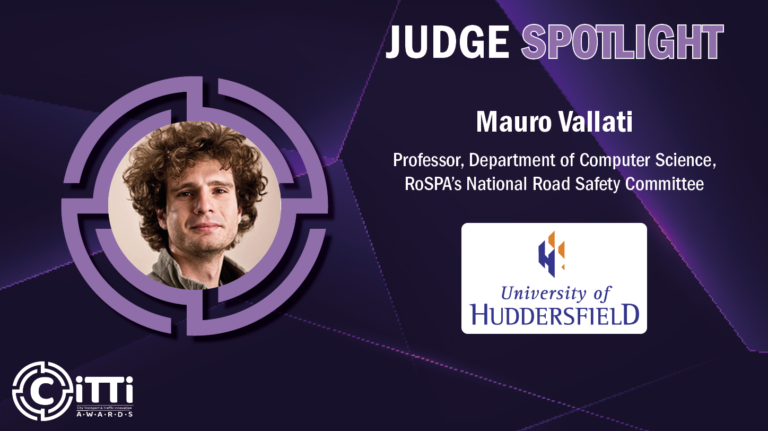With entries for the CiTTi Awards 2025 now open, City Transport & Traffic Innovation Magazine (CiTTi Magazine) has launched an exclusive series of Q&A interviews with the expert panel of judges responsible for assessing this year’s submissions.
In the weeks ahead, the magazine will shine a spotlight on each of the judges – a diverse group of leading professionals drawn from across the sustainable urban mobility and transport technology sectors – to explore their backgrounds, industry perspectives and what they’ll be looking for in an award-winning entry.
From public sector figures to academic and technical specialists, this year’s judging panel represents a broad spectrum of knowledge, insight and experience – all of which will help identify the most innovative, impactful and forward-thinking projects, products and people shaping the future of city transport and traffic innovation.
One of the judges taking part in the 2025 edition is Mauro Vallati, professor, Department of Computer Science, University of Huddersfield, where he leads the AI4UTMC research team.
Vallati is also an ACM senior member and distinguished speaker, with expertise in applying AI to real-world challenges, including healthcare and train dispatching.
Since 2016, he has led multiple research grants in urban traffic control, resulting in high-impact publications and patents in the UK, China, and the US.
In 2021, Vallati received a UKRI Future Leaders Fellowship to develop AI systems capable of autonomously detecting traffic congestion and adjusting signals to optimise urban traffic flow.
Speaking to CiTTi Magazine, Vallati delved into the practical implementation challenges and successes associated with different innovative solutions.

Name: Mauro Vallati
Job title: Professor, Department of Computer Science
Organisation: University of Huddersfield
How does your professional expertise align with the CiTTi Awards’ mission to recognise and celebrate innovation in urban mobility?
As a researcher, I have been working on the field of applications of AI techniques to intelligent transport systems for over a decade. I’ve a deep understanding of approaches for optimising various facets of urban mobility. This includes areas like intelligent traffic management, dynamic routing for public transport and on-demand services. This allows me to assess the novelty and effectiveness of AI-driven solutions aimed at improving the flow of people and goods within cities.
Additionally, my research in explainable AI (XAI) and transparent decision-making is relevant to ensuring public trust and acceptance of innovative urban mobility solutions, particularly those involving AI. The CiTTi Awards value solutions that are not only effective but also understandable and accountable. My expertise allows me to assess how well innovations address these crucial aspects.
Finally, my work often involves interdisciplinary collaboration, bringing together insights from computer science, transportation engineering, urban planning, and policy. This aligns perfectly with the multifaceted nature of urban mobility challenges and the need for holistic, integrated solutions that the CiTTi Awards aim to highlight. I can appreciate and evaluate the synergy between different disciplines in driving impactful innovation.
What emerging trends or technologies in urban mobility and transport are you most excited about, and how do you expect them to be reflected in this year’s submissions?
I am particularly interested in solutions that enhance the flexibility and appeal of public transportation. This domain has the potential to significantly improve urban mobility and support decarbonisation efforts. It is also an interdisciplinary and dynamic field, requiring a balance of costs, level of service, trust, and utility for users.
As a judge, what insights do you hope to gain from reviewing the submissions, and how might this experience shape your perspective or influence your work in the sector?
I am particularly interested in understanding the practical implementation challenges and successes associated with different innovative solutions. The submissions will likely offer insights into the real-world hurdles encountered during development and deployment, as well as the strategies employed to overcome them. Learning from these experiences – both the triumphs and the setbacks – will be invaluable.
I am also very keen to evaluate the impact and scalability of the submitted innovations. This is usually a crucial issue for this class of approaches. Beyond the initial concept, I want to understand the evidence for the positive effects these solutions are having on urban environments and the potential for their wider adoption in different contexts. This will help me discern truly transformative innovations from more localised or niche solutions.
In your opinion, how do the CiTTi Awards contribute to driving meaningful progress and innovation in urban mobility, and why is industry recognition so important?
The Awards act as a powerful catalyst for visibility and knowledge sharing. By showcasing innovative projects, technologies, and initiatives, the CiTTi Awards bring them to the attention of a wider audience, including industry professionals, policymakers, researchers, and the public. This increased visibility fosters awareness of successful models and encourages the adoption and adaptation of best practices across different urban environments.
The Awards provide valuable validation and credibility to the winners and finalists. Independent recognition from a respected body like the CiTTi Awards serves as a strong endorsement of the effectiveness and impact of their work. This validation can be crucial for attracting talent and building partnerships necessary for scaling and sustaining innovative solutions. Industry recognition is crucial in building trust and confidence, attracting funding, and facilitating collaborations and partnerships.
Can you share an example of an innovation or initiative that has significantly impacted urban mobility?
The rise of on-demand services, ranging from ride-hailing to delivery services, has revolutionised urban mobility. They’ve provided convenient door-to-door travel, particularly filling gaps in traditional public transit and offering first/last mile solutions. While raising questions about congestion, equity, and integration, they’ve undeniably increased transportation choices and spurred innovation in how people move within cities, forcing traditional systems to consider more user-centric approaches.
What advice would you give to companies and organisations looking to submit an award-winning entry?
The inability to convincingly answer the fundamental questions of “What?” and “Why now?” is a recurring pitfall I’ve observed in reviewing numerous submissions over the years. Even the most technically impressive or conceptually novel projects can fall short if they fail to articulate these core elements with clarity. The “What?” question goes beyond simply describing your project or technology.
It demands a precise and easily understandable definition of the core problem you are solving or the opportunity you are addressing within the urban mobility landscape. The “Why now?” question requires a compelling justification for the timeliness and urgency of your solution, and needs an understanding of the context in which you are operating. Why is this the right moment for this particular innovation? What existing trends, emerging challenges, or technological advancements make your solution particularly relevant and necessary now?
Achievements and innovations in urban mobility will be recognised and celebrated at the fourth annual CiTTi Awards on 25 November 2025 at De Vere Grand Connaught Rooms in London. Visit www.cittiawards.co.uk to learn more about this unmissable event for the UK’s transportation sector!





